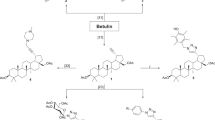Abstract
Here we report on the results obtained from an antiviral screening, including herpes simplex virus, vaccinia virus, vesicular stomatitis virus, Coxsackie B4 virus or respiratory syncytial virus, parainfluenza-3 virus, reovirus-1 and Punta Toro virus, of three 2-hydroxy-3-methoxyphenyl acylhydrazone compounds in three cell lines (i.e. human embryonic lung fibroblast cells, human cervix carcinoma cells, and African Green monkey kidney cells). Interesting antiviral EC50 values are obtained against herpes simplex virus-1 and vaccinia virus. The biological activity of acylhydrazones is often attributed to their metal coordinating abilities, so potentiometric and microcalorimetric studies are here discussed to unravel the behavior of the three 2-hydroxy-3-methoxyphenyl compounds in solution. It is worth of note that the acylhydrazone with the higher affinity for Cu(II) ions shows the best antiviral activity against herpes simplex and vaccinia virus (EC50 ~ 1.5 µM, minimal cytotoxic concentration = 60 µM, selectivity index = 40).





Similar content being viewed by others
References
Ali Kamyabi M, Shahabi S, Hosseini-Monfared H (2008) Spectrophotometric and potentiometric study of (E)-N′-(2-hydroxy-3-methoxybenzylidene)benzohydrazide with a ferric ion in the methanol–water mixture. J Chem Eng Data 53:2341–2345
Bacchi A, Carcelli M, Compari C, Fisicaro E, Pala N, Rispoli G, Rogolino D, Sanchez TM, Sechi M, Neamati N (2011) HIV-1 IN strand transfer chelating inhibitors: a focus on metal binding. Mol Pharm 8:507–519
Bleichert P, Espìrito Santo Ch, Hanczaruk M, Meyer H, Grass G (2014) Inactivation of bacterial and viral biothreat agents on metallic copper surfaces. Biometals 27:1179–1189
Carcelli M, Rogolino D, Gatti A, De Luca L, Sechi M, Kumar G, White SW, Stevaert A, Naesens L (2016) N-acylhydrazone inhibitors of influenza virus PA endonuclease with versatile metal binding modes. Sci Rep 6:31500
Chana AN, Shiverb AL, Weverc WJ, Zeenat S, Razvid A, Traxlere MF, Lia B (2017) Role for dithiolopyrrolones in disrupting bacterial metal homeostasis. PNAS 114:2717–2722
Fisicaro E, Braibanti A (1988) Potentiometric titrations in methanol/water medium: intertitration variability. Talanta 10:769–774
Fisicaro E, Compari C, Bacciottini F, Contardi L, Carcelli M, Rispoli G, Rogolino D (2014) Thermodynamics of complexes formation by ITC in methanol/water = 9/1 (v/v) solution: a case study. Thermochim Acta 586:40–44
Gans P, Sabatini A, Vacca A (1996) Investigation of equilibria in solution. Determination of equilibrium constants with HYPERQUAD suite of programs. Talanta 43:1739–1753
Gans P, Sabatini A, Vacca A (2008) Simultaneous calculation of equilibrium constants and standard formation enthalpies from calorimetric data for systems with multiple equilibria in solution. J Solut Chem 37:467–476
Gran P (1952) Determination of the equivalence point in potentiometric titrations. Part II. Analyst 77:661–671
Helsel ME, Franz KJ (2015) Pharmacological activity of metal binding agents that alter copper bioavailability. Dalton Trans 44:8760–8770
Jiang Q, Sicking W, Ehlers M, Schmuck C (2015) Discovery of potent inhibitors of human β-tryptase from pre-equilibrated dynamic combinatorial libraries. Chem Sci 6:1792–1800
Kim B, Ko H, Jeon E, Ju E, Jeong LS, Kim Y (2016) 2,3,4-Trihydroxybenzyl-hydrazide analogues as novel potent coxsackievirus B3 3C protease inhibitors. Eur J Med Chem 120:202–216
Pouralimardan O, Chamayou A, Janiak Ch, Hosseini-Monfared H (2007) Hydrazone Schiff base-manganese(II) complexes: synthesis, crystal structure and catalytic reactivity. Inorg Chim Acta 360:1599–1608
Ray A, Rizzoli C, Pilet G, Desplanches C, Garribba E, Rentschler E, Mitra S (2009) Two new supramolecular architectures of singly phenoxo-bridged copper(II) and doubly phenoxo-bridged manganese(II) complexes derived from an unusual ONOO donor hydrazone ligand: syntheses, structural variations, cryomagnetic, DFT, and EPR studies. Eur J Inorg Chem 20:2915–2928
Rogolino D, Carcelli M, Compari C, De Luca L, Ferro S, Fisicaro E, Rispoli G, Neamati N, Debyser Z, Christ F, Chimirri A (2014) Diketoacid chelating ligands as dual inhibitors of HIV-1 integration process. Eur J Med Chem 78:425–430
Rogolino D, Carcelli M, Bacchi B, Compari C, Contardi L, Fisicaro E, Gatti A, Sechi M, Stevaert A, Naesens L (2015) A versatile salicyl hydrazonic ligand and its metal complexes as antiviral agents. J Inorg Biochem 150:9–17
Sayed AM, Choi S, Lee D (2017) Synthesis, anticancer, and docking studies of salicyl-hydrazone analogues: a novel series of small potent tropomyosin receptor kinase A inhibitors. Bioorg Med Chem 25:389–396
Vantomme G, Lehn J (2013) Photo- and thermoresponsive supramolecular assemblies: reversible photorelease of K+ ions and constitutional dynamics. Angew Chem Int Ed 52:3940–3943
Vrdoljak V, Pavlovic´ G, Maltar-Strmecˇki N, Cindric´ M (2016) Copper(II) hydrazone complexes with different nuclearities and geometries: synthetic methods. New J Chem 40:9263–9274
Warnes SL, Keevil CW (2013) Inactivation of Norovirus on dry copper alloy surfaces. PLoS ONE 8:e75017
Weekley CM, He C (2017) Developing drugs targeting transition metal homeostasis. Curr Op Chem Biol 37:26–32
Acknowledgements
‘‘Centro Interdipartimentale Misure Giuseppe Casnati” of the University of Parma is thanked for facilities.
Author information
Authors and Affiliations
Contributions
The manuscript was written through contributions of all authors. All authors have given approval to the final version of the manuscript.
Corresponding author
Electronic supplementary material
Below is the link to the electronic supplementary material.
Rights and permissions
About this article
Cite this article
Carcelli, M., Fisicaro, E., Compari, C. et al. Antiviral activity and metal ion-binding properties of some 2-hydroxy-3-methoxyphenyl acylhydrazones. Biometals 31, 81–89 (2018). https://doi.org/10.1007/s10534-017-0070-6
Received:
Accepted:
Published:
Issue Date:
DOI: https://doi.org/10.1007/s10534-017-0070-6




